


Siem Reap feels like stepping into a living storybook where ancient history and vibrant local life dance together effortlessly. The moment you arrive,there’s this warm,inviting energy—friendly smiles from tuk-tuk drivers,the hum of motorbikes weaving through bustling markets,and the scent of lemongrass and grilled street food mingling in the air. It’s a place where the past isn’t just preserved behind glass but pulses through every corner,especially when you wander the awe-inspiring temples of Angkor at sunrise,watching the soft golden light spill over intricate stone carvings and jungle vines. Beyond the temples,the town itself is a lively mosaic of colorful markets,cozy cafés,and lively night bazaars. You’ll hear the chatter of locals bargaining over fresh produce,the clinking of glasses in open-air bars,and the occasional traditional Khmer music drifting from a nearby restaurant. The food scene is a delicious adventure—imagine biting into a crispy,fragrant fish amok or savoring sweet mango sticky rice while sitting under a canopy of twinkling lights. What really makes Siem Reap special is its balance of old and new,calm and excitement. You can spend your mornings exploring centuries-old ruins and your afternoons relaxing with a foot massage or cycling through rice paddies. It’s a place that invites you to slow down,soak in the stories,and feel connected—not just to Cambodia’s rich heritage but to the warm-hearted people who call it home.
The information on this page is currently being reviewed by Tripkliq and should be used as a guide only
Eng word: Hello
Eng pronunciation: suo sdei
Local language: សួស្តី
Eng word: Goodbye
Eng pronunciation: lea howie
Local language: លាហើយ
Eng word: Thank you
Eng pronunciation: aw kohn
Local language: អរគុណ
Eng word: How much
Eng pronunciation: bon man
Local language: ប៉ុន្មាន
Eng word: Toilet
Eng pronunciation: bong kohn
Local language: បង្គន់
Eng word: Help me
Eng pronunciation: chouy khnhom
Local language: ជួយខ្ញុំ
Eng word: Yes
Eng pronunciation: baat (for males) / chaa (for females)
Local language: បាទ/ចាស
Eng word: No
Eng pronunciation: te
Local language: ទេ
Eng word: Excuse me
Eng pronunciation: som toh
Local language: សូមទោស
Angkor Wat, the largest religious monument in the world, was built in the early 12th century by King Suryavarman II. It is a UNESCO World Heritage site and a symbol of Cambodia.
Bayon Temple, located in the center of Angkor Thom, is famous for its 54 towers decorated with over 200 smiling faces of Avalokiteshvara. It was built in the late 12th century by King Jayavarman VII.
Ta Prohm, also known as the 'Tomb Raider Temple,' is renowned for the giant trees and roots growing out of its ruins. It was built in the late 12th and early 13th centuries as a Buddhist monastery and university.
Banteay Srei, often referred to as the 'Citadel of Women,' is known for its intricate carvings and pink sandstone construction. It was built in the 10th century and dedicated to the Hindu god Shiva.
Angkor Thom, meaning 'Great City,' was the last and most enduring capital city of the Khmer Empire. It was established in the late 12th century by King Jayavarman VII and covers an area of 9 square kilometers.
Preah Khan, meaning 'Sacred Sword,' was built in the 12th century by King Jayavarman VII. It served as a Buddhist monastery and university, and is known for its well-preserved carvings and extensive layout.
Phnom Bakheng is a Hindu and Buddhist temple in the form of a temple mountain. Built in the late 9th century, it offers a panoramic view of Angkor Wat and is a popular spot for watching sunsets.
The Angkor National Museum in Siem Reap offers a comprehensive look at the history, culture, and art of the Khmer civilization. It features eight galleries with artifacts from the Angkorian period.
The Old Market, or Psar Chaa, is one of the oldest markets in Siem Reap. It offers a variety of local goods, souvenirs, and traditional Cambodian food, providing a glimpse into the local culture and daily life.
In Siem Reap, the most common Power Adaptor is Type A, Type C, Type G.






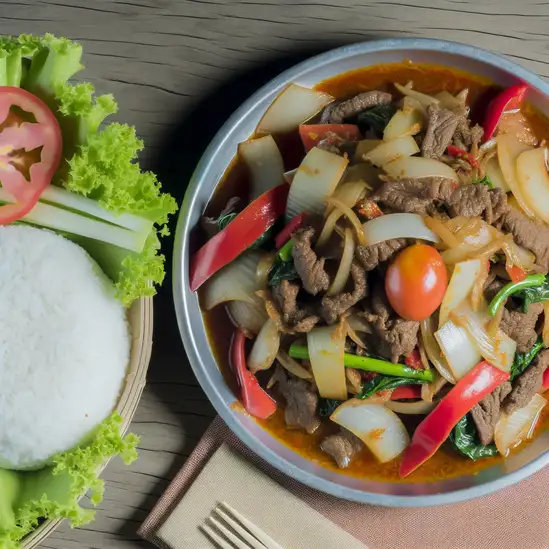
Stir-fried beef served with a tangy dipping sauce, often accompanied by rice and a side of fresh vegetables.
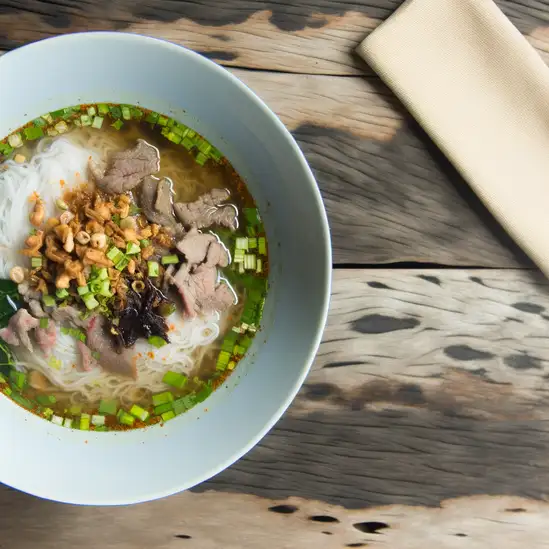
A noodle soup made with rice noodles, typically served with a variety of toppings such as beef, pork, or seafood, and garnished with herbs.
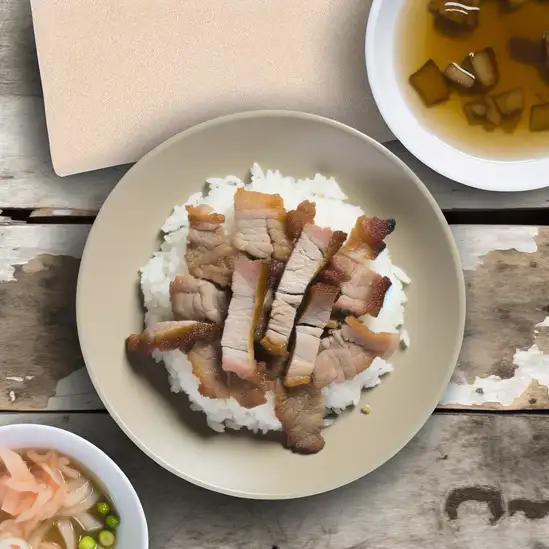
Grilled pork served over rice, often accompanied by pickled vegetables and a side of broth.

A traditional Cambodian curry made with fish, coconut milk, and a blend of spices, often steamed in banana leaves.
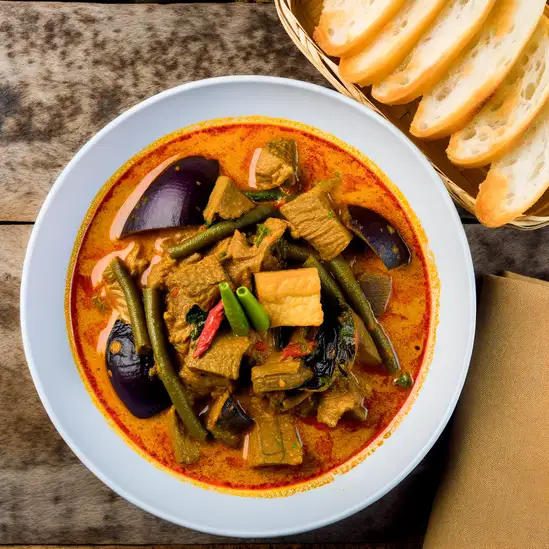
A fragrant curry made with beef, chicken, or fish, cooked with coconut milk, eggplant, and green beans, typically served with bread.

A popular breakfast dish consisting of rice noodles topped with a fish-based green curry sauce and fresh herbs and vegetables.

A rich and flavorful dip made from fermented fish paste, coconut milk, and minced pork, usually served with fresh vegetables.
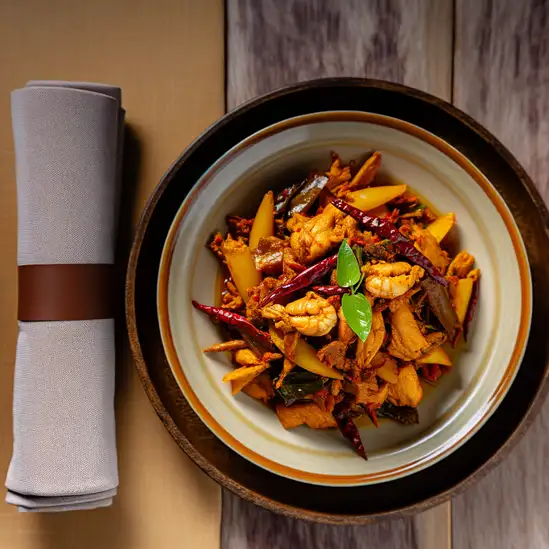
Stir-fried dishes made with a fragrant Khmer spice paste called kroeung, often featuring chicken or seafood.
Bangkok is one of those cities that grabs you the moment you step out into its bustling streets. There’s this electric energy in the air—a mix of honking tuk-tuks,sizzling street food stalls,and the chatter of locals weaving through markets. The city feels alive,like it’s constantly moving and breathing,yet somehow it balances this chaos with moments of serene beauty,like the golden spires of temples catching the afternoon sun or quiet canals reflecting the sky.
Walking through Bangkok,you’ll be hit by a whirlwind of scents:fragrant jasmine from flower vendors,the sharp tang of lemongrass and chili from street carts,and the sweet aroma of mango sticky rice tempting you at every corner. The colors are just as vivid—neon signs flicker alongside traditional wooden shophouses,and monks in saffron robes glide past modern skyscrapers. It’s a city where old and new dance together effortlessly.
What really makes Bangkok special is its warmth and openness. The people here have a genuine kindness that shines through,whether you’re bargaining at Chatuchak Market or sharing a laugh over a bowl of spicy boat noodles. The culture is rich and layered,from the intricate rituals at Wat Pho to the lively festivals that light up the streets. Visiting Bangkok feels like stepping into a story that’s still unfolding,full of surprises and moments that stay with you long after you leave.
Imagine stepping into a place where the air hums with the gentle rhythm of waves lapping against sun-warmed shores,and the scent of salty sea mingles with fragrant street food stalls. That’s Phuket for you—a vibrant island that feels alive in every sense. It’s not just the stunning beaches that grab you,but the way the island pulses with a laid-back energy,where colorful markets buzz with chatter and the aroma of grilled seafood fills the air. Walking through the old town,you’ll find charming Sino-Portuguese buildings painted in pastel hues,their shutters creaking softly in the tropical breeze,while tuk-tuks zip by,adding a playful soundtrack to your explorations.
Phuket’s character is a beautiful blend of tradition and liveliness. Temples with golden spires peek out from lush greenery,inviting quiet moments of reflection,while nearby,night markets burst with life—vendors calling out,sizzling woks,and the sweet tang of mango sticky rice tempting your taste buds. The island’s culture is warm and welcoming,with locals who smile easily and share stories over cups of strong Thai coffee or fresh coconut water.
What makes Phuket truly special is how it wraps you in its embrace—whether you’re watching a fiery sunset from a cliffside bar,diving into crystal-clear waters teeming with vibrant marine life,or simply savoring the spicy kick of a freshly made curry. It’s a place that invites you to slow down,soak in the colors,sounds,and flavors,and leave with a heart full of unforgettable moments.
Ho Chi Minh City pulses with an energy that’s impossible to ignore—like the city itself is alive,breathing through its bustling streets and vibrant markets. The moment you step out,you’re greeted by a symphony of honking scooters weaving through the maze of narrow alleys,the sizzling sound of street food grilling on every corner,and the rich aroma of fresh herbs mingling with strong Vietnamese coffee. It’s chaotic but in the best way,a place where tradition and modernity collide in colorful,unexpected ways.
Walking through District 1,you’ll catch glimpses of French colonial architecture standing proudly beside sleek skyscrapers,while locals sip iced cà phê sữa đá at tiny plastic stools,chatting animatedly. The city’s character is raw and real—no polished tourist traps here,just genuine moments and warm smiles. At night,the streets transform as neon signs flicker on,and the scent of grilled seafood and sweet bánh mì fills the air,inviting you to taste the city’s soul.
What makes Ho Chi Minh City truly unforgettable is its resilience and spirit. It’s a place where history whispers from the War Remnants Museum and the Cu Chi Tunnels,yet life moves forward with a youthful,entrepreneurial buzz. Whether you’re savoring a bowl of pho at dawn or exploring vibrant art galleries and rooftop bars,the city wraps you in its embrace,making you feel like you’re part of its ongoing story.
Kuala Lumpur feels like a vibrant heartbeat pulsing through the heart of Malaysia—where tradition and modernity dance effortlessly together. The moment you step into the city,you’re greeted by the towering silhouettes of the Petronas Twin Towers piercing the sky,their glass facades shimmering against the tropical sun. But it’s not just the skyline that captivates you; it’s the lively street scenes below. The air buzzes with the chatter of street vendors,the sizzle of satay grilling over open flames,and the sweet aroma of pandan and lemongrass wafting from bustling food stalls.
Walking through neighborhoods like Bukit Bintang or Chinatown,you’ll find a kaleidoscope of colors and sounds—vibrant markets brimming with spices,textiles,and handcrafted trinkets,while the calls to prayer from nearby mosques blend harmoniously with the hum of city life. The city’s rich cultural tapestry is woven from Malay,Chinese,and Indian influences,creating a unique blend you can taste in every bite of nasi lemak or teh tarik.
What I love most is how Kuala Lumpur never feels rushed. Whether you’re sipping kopi at a roadside stall or wandering through the lush greenery of the KL Forest Eco Park,there’s a warm,welcoming energy that invites you to slow down and soak it all in. It’s a city that surprises you at every turn—full of contrasts,flavors,and stories waiting to be discovered.
Manila is this vibrant,bustling heart of the Philippines that grabs you the moment you step off the plane. There’s an energy here that’s both chaotic and warm,like the city is alive and breathing with stories waiting to be discovered. Walking through its streets,you’ll catch the scent of sizzling street food mingling with the salty breeze from Manila Bay. The soundscape is a lively mix of jeepneys honking,street vendors calling out their wares,and the occasional laughter spilling from a nearby sari-sari store.
What makes Manila truly special is its rich tapestry of history and culture woven into everyday life. You can wander through Intramuros,the old walled city,and feel the echoes of Spanish colonial days in the cobblestone streets and centuries-old churches. Then,just a few blocks away,modern skyscrapers rise,showcasing the city’s dynamic spirit. The people here are incredibly warm and welcoming,always ready to share a story or recommend their favorite spot for halo-halo,a sweet,icy treat that’s perfect for cooling down in the tropical heat.
Manila’s charm lies in its contrasts—the old and new,the quiet moments in hidden courtyards and the lively buzz of night markets. It’s a place where you can savor rich Filipino flavors,dive into vibrant festivals,and feel the pulse of a city that’s constantly evolving but never loses its heart. If you want a trip that’s full of life,color,and genuine warmth,Manila’s waiting with open arms.
Bali feels like stepping into a vibrant dream where every corner pulses with life and warmth. From the moment you arrive,there’s this unmistakable energy—part spiritual,part playful—that wraps around you like a soft,tropical breeze. Imagine waking up to the gentle rustle of palm leaves and the distant sound of waves crashing against volcanic black sand beaches. The air carries a mix of frangipani blossoms and salty sea spray,instantly grounding you in the island’s natural beauty.
What really makes Bali special is its rich culture woven into everyday life. You’ll see locals in colorful sarongs offering flowers at temple steps,hear the rhythmic beat of gamelan music drifting through the air,and catch glimpses of intricate wood carvings and vibrant paintings in small artisan shops. The island’s spirituality isn’t just something you observe—it’s something you feel,a quiet presence that invites you to slow down and connect.
And then there’s the food—oh,the food! Freshly grilled satay,fragrant nasi campur bursting with spices,and tropical fruits so sweet they almost taste like candy. Whether you’re dining in a bustling market or a cliffside café overlooking the ocean,every bite feels like a celebration of Bali’s rich flavors and traditions. Honestly,Bali isn’t just a place you visit; it’s a place that stays with you,long after you’ve left.
Unlicensed money changers may give you counterfeit bills or shortchange you during the transaction.
Individuals may pose as representatives of charities, collecting donations that never reach the intended cause.
Scammers may solicit donations for fake orphanages, exploiting tourists' goodwill.
Tourists may be offered 'special deals' on gemstones that turn out to be fake or of very low quality.
Rental agencies may claim damage to the bike that was already there, demanding high repair fees.
Locals in traditional attire may offer to take photos with you and then demand a high fee afterward.
Some establishments may add extra items to your bill or inflate prices, especially if you appear to be unfamiliar with the local currency.
Children or women with babies may beg for money, often part of organized scams where the money does not go to those in need.
Unlicensed guides may offer their services at Angkor Wat and other temples, providing inaccurate information and charging high fees.
Tuk-tuk drivers may quote exorbitant prices for short rides, especially if they see you are a tourist.
Cambodia has strict laws against the possession, use, and trafficking of illegal drugs. Penalties can be severe, including long prison sentences and heavy fines. Tourists should avoid any involvement with illegal drugs while in Siem Reap or anywhere in Cambodia. Even small amounts of drugs can lead to serious legal consequences.
In Siem Reap, Cambodia, smoking is generally allowed in public places, but there are restrictions in certain areas such as temples, historical sites, and some indoor public spaces. It is advisable to look for designated smoking areas and to be respectful of local customs and regulations. Smoking is prohibited in enclosed public spaces, including restaurants and bars, unless there is a designated smoking area.
Vaping is not specifically regulated in Cambodia, including Siem Reap. However, it is generally treated similarly to smoking. Tourists should exercise caution and follow the same guidelines as for smoking, avoiding vaping in non-smoking areas and being mindful of local customs and regulations.
What are other people saying about Siem Reap?
Recent Social posts about Siem Reap
There is nothing to show you for now.